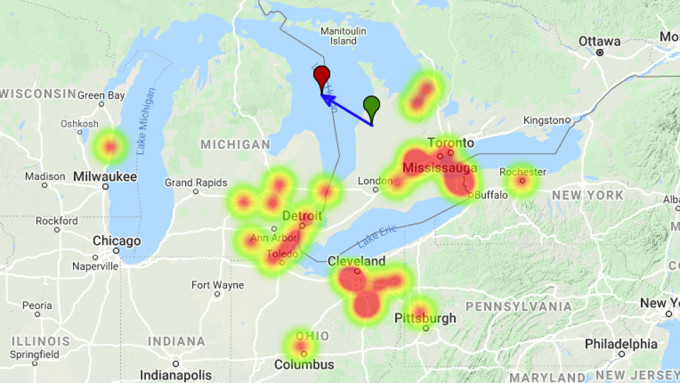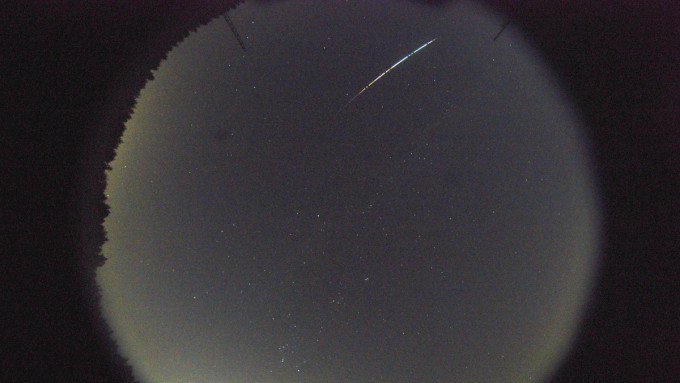It even changed colours as it streaked across the sky.
Lisa Belmonte1 day ago
Updated on January 25

Alan Chen | Unsplash
Parts of the province got an otherworldly visitor that flashed across the dark sky and it had a long journey to get there. A meteor over Ontario came all the way from the asteroid belt which is beyond Mars. Videos and pictures of the space object streaking through the night are spectacular.
If you were in southern Ontario on January 21 and looked up just before 9:00 p.m. you might have seen a bright light streak across the night sky.
That was a meteor fireball that was likely the size of a softball.
It flashed overhead just to the north of Goderich and was spotted by people from hundreds of kilometres away.
Reports about the fireball were sent in from southern Ontario, Michigan, Wisconsin, New York and Ohio.
Peter Brown, a meteor scientist from Western University, posted videos on Twitter of the celestial object lighting up the sky.
This visitor from outer space lit up about 80 kilometres above the ground and started just east of the Ontario town.
It eventually fizzled out north of the town, about 30 kilometres above Lake Huron.
Based on the path it took through the atmosphere, Brown was able to trace its origin back to the asteroid belt which is just beyond Mars.
If any small meteorites actually fell from the sky, they likely ended up in the lake
Kintail fireball from Jan 22 as captured early in flight by accident on @westernu most sensitive meteor cameras which use EMCCDs from @nuvucameras. FOV is roughly 15x15 degrees and faintest visible stars are near +12. @amsmeteors @IMOmeteors #fireball #Meteorite pic.twitter.com/exv1OqHPr4— Peter Brown (@pgbrown) January 23, 2020
Yet another capture of the Kintail fireball, this time with an experimental meteor camera system near Tavistock, ON based on https://t.co/JMV1A8Nciu @westernu @IMOmeteors @amsmeteors #fireball #toomanymeteorcameras pic.twitter.com/ZVtQ3aOqd0— Peter Brown (@pgbrown) January 23, 2020
A meteor is a streak of light across the sky that happens when space rocks, known as "meteoroids" enter Earth's atmosphere.
Since this flash was intense enough to rival the brightness of Venus, it's called a fireball.
Usually, cameras set up to shoot events like this only capture black and white but two of them actually caught this streak changing colours as it flashed through the sky.
In both photos, you can see the fireball change from red to white to blue and back to red again.
Still image of Kintail fireball last night as seen from Collingwood Observatory of @TCObs pic.twitter.com/gyr1wDthTc— Peter Brown (@pgbrown) January 22, 2020
Still image of Kintail fireball from Elginfield Observatory as captured by @FireballsSky DFN camera last night. @amsmeteors @FireballsSky pic.twitter.com/ClTBr3M96d— Peter Brown (@pgbrown) January 22, 2020
The colour of the space rock could be based on what it's made of, the flow of air around it, the speed it travelled at or how it broke apart.
The asteroid belt is between 179.5 and 329 million kilometres away from Earth.
So this little guy travelled a long way to flash across the sky over southern Ontario.
Fireball ‘as bright as the moon’ lands in Lake Huron
Posted Jan 25, 2020
By Tanda Gmiter | tgmiter@mlive.com
A fast, bright burst of what were probably softball-size meteors caught the attention of our Canadian neighbors earlier this week, before likely arcing down to land in Lake Huron.
While it wasn’t seen by too many sky-watchers on the U.S. side of Lake Huron, observatories in Canada, including Western University in London, Ontario, captured an image of the fireball last Tuesday night. It likely was a collection of small meteors grouped together, researchers say, according to CTV News in Canada.,
Spotters say the fireballs looked “as bright as the moon” as they whizzed across the sky.
In a Reddit discussion titled “orange fireball in night sky," a handful of people talked about seeing the fireball overhead.
“Anyone see this incredible sight around 9:10 pm in the sky north of London? An orange fireball streaming across the sky," one person wrote.
“Yes!!! Saw it driving home a few minutes ago. I’ve never seen anything like it before!,” another person posted.
Others who saw it chimed in:
“Yes! Omg my husband and I saw this. We were near Masonville mall! It was so bright. I’ve never seen anything like that. With I had a dash cam to capture it.”
“Was sitting at Carey’s and I saw it for a split second. Buddies thought I was nuts. Was cool though.”
“Yeah we saw it on a walk last night. It was around 9. Wonderland and Oxford area. It was tracking north fairly slowly. Saw the white ball, orange tail, and even saw some bits breaking off of it.”
Peter Brown, a professor in Western University’s physics and astronomy department, tweeted a series of photos of the spectacle. He dubbed it the Kintail fireball, for the spot near the Canadian shoreline of Lake Huron where it was believed to have crossed over before going into the water. On a map, Kintail is directly across the lake from Michigan’s Thumb.
“Kintail fireball orbit from last night place origins firmly from the asteroid belt. The initial mass was somewhere between a few to ten kilograms - softball sized. Not quite as bright as the full moon," Brown posted on Twitter.
Fireballs are born when particles of meteors hit the Earth’s atmosphere and burn their way across the sky.
There were some reports of this particular fireball from U.S. sky watchers. These came from people in Port Huron, Flint and St. Clair Shores in Michigan, and other spots in Ohio and New York, as reported to the American Meteor Society.
Bright fireball last night at 8:52 pm EST to the North of London. Video below shot from @WesternU @westernuCRONYN. @amsmeteors #fireball #meteor 1/3 pic.twitter.com/vjfV11OAL2— Peter Brown (@pgbrown) January 22, 2020
Fireball started near Brussels and ended just offshore over Lake Huron near Kintail. Low velocity (~15 km/s) and end height (33 km) suggest small meteorites may have landed, likely in Lake Huron. @WesternU @IMOmeteors #fireball 2/3 pic.twitter.com/Mrbs4IUson— Peter Brown (@pgbrown) January 22, 2020
Still image of Kintail fireball from Elginfield Observatory as captured by @FireballsSky DFN camera last night. @amsmeteors @FireballsSky pic.twitter.com/ClTBr3M96d— Peter Brown (@pgbrown) January 22, 2020
Kintail fireball from Jan 22 as captured early in flight by accident on @westernu most sensitive meteor cameras which use EMCCDs from @nuvucameras. FOV is roughly 15x15 degrees and faintest visible stars are near +12. @amsmeteors @IMOmeteors #fireball #Meteorite pic.twitter.com/exv1OqHPr4— Peter Brown (@pgbrown) January 23, 2020
Yet another capture of the Kintail fireball, this time with an experimental meteor camera system near Tavistock, ON based on https://t.co/JMV1A8Nciu @westernu @IMOmeteors @amsmeteors #fireball #toomanymeteorcameras pic.twitter.com/ZVtQ3aOqd0— Peter Brown (@pgbrown) January 23, 2020

Photo of a meteor captured by cameras of Western's Southern Ontario Meteor Network.
Fireball recorded in Huron County
BY JANICE MACKAYJANUARY 23, 2020 3:31PM
Video cameras from Western University captured a fireball in Huron County Thursday night.
UWO Meteor Scientist Peter Brown tweeted several images and videos of the fireball.
He reported that the fireball started near Brussels and ended just offshore over Lake Huron near Kintail.
He said a low velocity and an end height of 33 kilometres suggests small meteorites may have landed, likely in Lake Huron.
Yet another capture of the Kintail fireball, this time with an experimental meteor camera system near Tavistock, ON based on https://t.co/JMV1A8Nciu @westernu @IMOmeteors @amsmeteors #fireball #toomanymeteorcameras pic.twitter.com/ZVtQ3aOqd0
— Peter Brown (@pgbrown) January 23, 2020







/arc-anglerfish-tgam-prod-tgam.s3.amazonaws.com/public/SUJCYX4PVJATLAAESP2JTEREGU.jpg)
